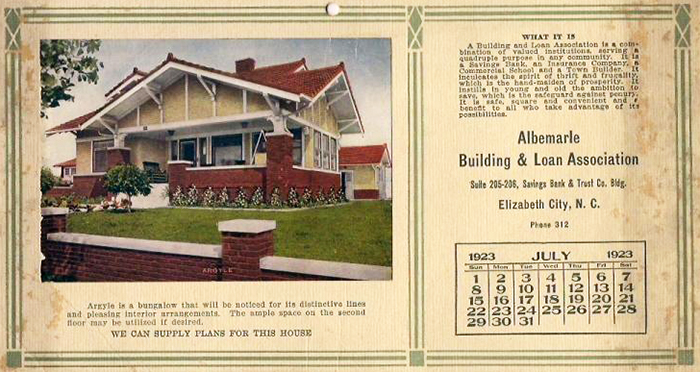Building and Loan Associations are the direct descendants of English building societies, which began in Birmingham, England, in 1781. In America, organizations such as the Oxford Provident Building Association in Pennsylvania (1831) were created to allow subscribers, most of whom were textile workers, to build or purchase houses on a monthly payment plan. A homestead and building associations bill was ratified by the North Carolina General Assembly in 1870. A decade passed, however, before the first building and loan association was organized in the state. The work of A. G. Brenizer led to the formation of the Mutual Building and Loan Association in Charlotte in April 1881. Mechanics Perpetual Building and Loan Association of Charlotte followed in February 1883. With the exception of the Wilmington area, most of the state's early building and loan activity was in the Piedmont, as the associations gave the hope of home ownership to wage-earners lured from rural areas by manufacturing and service jobs in the state's growing cities. Associations were also formed in Monroe (1885); Salisbury (1886); Statesville (1887); and Concord, Rutherfordton, and Lenoir (1888). A strong Wilmington market produced three building and loan associations there, organized in 1885, 1887, and 1889, respectively.
Building and loan associations were welcomed by local communities because they significantly increased the number of home-owning citizens. The editor of the local newspaper in Concord opined on 1 June 1888 that

By 1911, only 30 years after the founding of the first building and loan association in North Carolina, there were 113 such organizations, with 25,174 members and assets of nearly $8.5 million. Building and loan associations survived both the Great Depression and the Second World War. During the late 1940s and 1950s they provided capital so that the young couples who produced the "baby boom" could purchase their own homes. The years that followed saw a dramatic change in the industry, however, as the associations moved from their traditional roles into offering diverse banking services. Many converted to stock-owned institutions. Deregulation produced a fiercely competitive climate and forced changes in the marketing of services. North Carolina's well-managed building and loan institutions survived the widespread national savings and loan failures in 1988, which were followed by adverse publicity and intensive regulation.